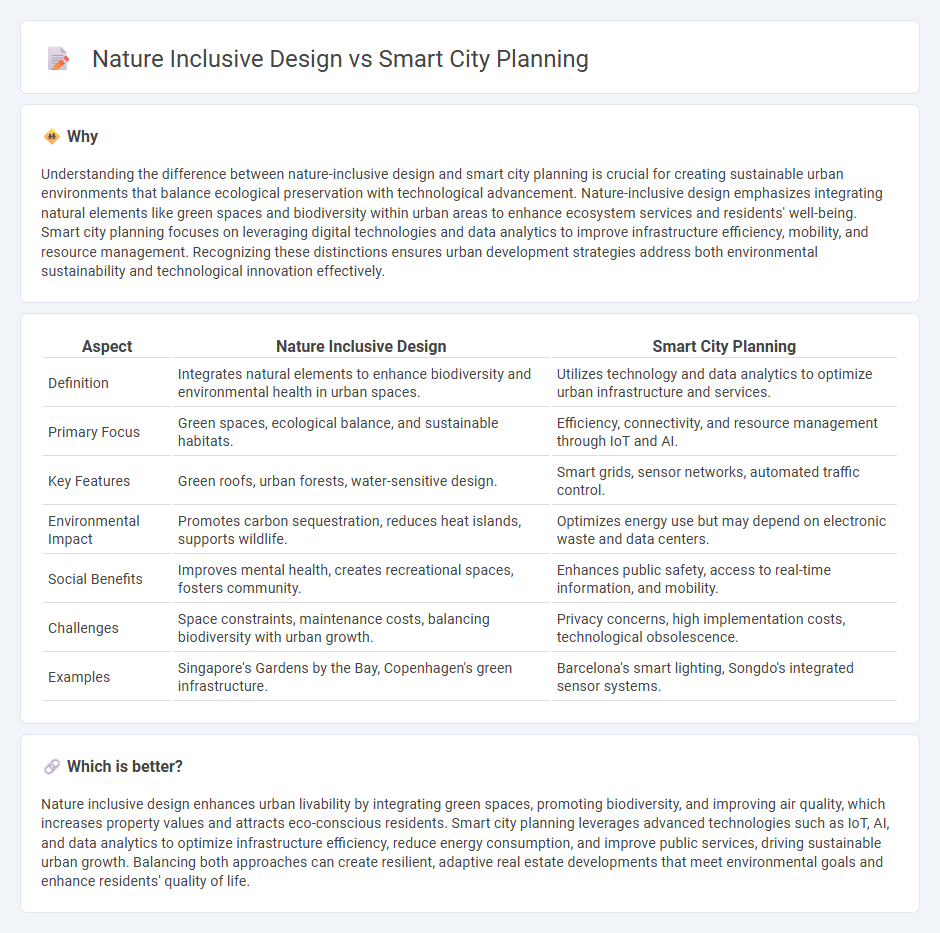
Nature-inclusive design integrates ecosystems and green spaces into urban real estate developments, enhancing biodiversity, air quality, and residents' well-being. Smart city planning leverages technology and data analytics to optimize infrastructure, energy use, and mobility, creating efficient and sustainable urban environments. Explore how these concepts redefine future urban living by balancing ecology and innovation.
Why it is important
Understanding the difference between nature-inclusive design and smart city planning is crucial for creating sustainable urban environments that balance ecological preservation with technological advancement. Nature-inclusive design emphasizes integrating natural elements like green spaces and biodiversity within urban areas to enhance ecosystem services and residents' well-being. Smart city planning focuses on leveraging digital technologies and data analytics to improve infrastructure efficiency, mobility, and resource management. Recognizing these distinctions ensures urban development strategies address both environmental sustainability and technological innovation effectively.
Comparison Table
| Aspect | Nature Inclusive Design | Smart City Planning |
|---|---|---|
| Definition | Integrates natural elements to enhance biodiversity and environmental health in urban spaces. | Utilizes technology and data analytics to optimize urban infrastructure and services. |
| Primary Focus | Green spaces, ecological balance, and sustainable habitats. | Efficiency, connectivity, and resource management through IoT and AI. |
| Key Features | Green roofs, urban forests, water-sensitive design. | Smart grids, sensor networks, automated traffic control. |
| Environmental Impact | Promotes carbon sequestration, reduces heat islands, supports wildlife. | Optimizes energy use but may depend on electronic waste and data centers. |
| Social Benefits | Improves mental health, creates recreational spaces, fosters community. | Enhances public safety, access to real-time information, and mobility. |
| Challenges | Space constraints, maintenance costs, balancing biodiversity with urban growth. | Privacy concerns, high implementation costs, technological obsolescence. |
| Examples | Singapore's Gardens by the Bay, Copenhagen's green infrastructure. | Barcelona's smart lighting, Songdo's integrated sensor systems. |
Which is better?
Nature inclusive design enhances urban livability by integrating green spaces, promoting biodiversity, and improving air quality, which increases property values and attracts eco-conscious residents. Smart city planning leverages advanced technologies such as IoT, AI, and data analytics to optimize infrastructure efficiency, reduce energy consumption, and improve public services, driving sustainable urban growth. Balancing both approaches can create resilient, adaptive real estate developments that meet environmental goals and enhance residents' quality of life.
Connection
Nature-inclusive design integrates green spaces, biodiversity, and sustainable resources into urban development, enhancing environmental quality and residents' well-being. Smart city planning leverages technology and data analytics to optimize infrastructure, energy use, and mobility, aligning with ecological objectives for resilient urban environments. Together, these approaches foster sustainable real estate projects that support climate adaptation, reduce carbon footprints, and promote harmonious coexistence between built and natural systems.
Key Terms
Urban Infrastructure
Smart city planning integrates advanced technologies like IoT, AI, and data analytics to optimize urban infrastructure for efficiency, sustainability, and resilience. Nature-inclusive design emphasizes green spaces, biodiversity, and ecosystem services within urban infrastructure to enhance environmental health and residents' well-being. Explore how combining these approaches can revolutionize urban living and infrastructure development.
Biodiversity Corridors
Biodiversity corridors play a crucial role in smart city planning by linking fragmented habitats and supporting urban wildlife migration and ecosystem services. Nature-inclusive design integrates green infrastructure such as parks, green roofs, and permeable surfaces to enhance habitat connectivity and promote ecological resilience. Discover how combining smart city strategies with biodiversity corridors can create sustainable urban environments that balance development and conservation.
Sustainable Land Use
Smart city planning integrates advanced technologies and data analytics to optimize land use efficiency and minimize environmental impact, promoting sustainable urban growth. Nature-inclusive design emphasizes preserving biodiversity by incorporating green spaces, natural habitats, and ecological corridors within urban landscapes to support ecosystem services. Explore how combining these approaches can revolutionize sustainable land use strategies.
Source and External Links
Smart Cities: The Future of Urban Planning - This article discusses how smart cities use data-driven decision-making, sustainable infrastructure, and enhanced mobility to revolutionize urban planning.
A Simple Guide to Smart City Planning and Development - This guide outlines steps for transitioning to a smart city by developing a long-term plan, automating with technology, and prioritizing people over technology.
Smart urban planning for cities of the future - This blog post highlights the role of smart urban planning in improving services, sustainability, resilience, and quality of life, as well as developing standards for smart city planners.
 dowidth.com
dowidth.com